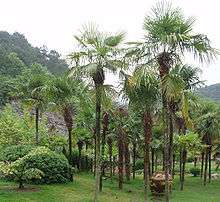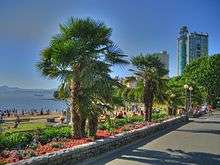Trachycarpus fortunei
| Trachycarpus fortunei | |
|---|---|
 | |
| Trees, China | |
| Scientific classification | |
| Kingdom: | Plantae |
| (unranked): | Angiosperms |
| (unranked): | Monocots |
| (unranked): | Commelinids |
| Order: | Arecales |
| Family: | Arecaceae |
| Genus: | Trachycarpus |
| Species: | T. fortunei |
| Binomial name | |
| Trachycarpus fortunei (Hook.) H.Wendl. | |
| Synonyms[1] | |
| |
Trachycarpus fortunei, the Chinese windmill palm,[2] windmill palm or Chusan palm, is a palm native to central China (Hubei southwards), southern Japan (Kyushu), south to northern Burma and northern India, growing at altitudes of 100–2,400 m (328–7,874 ft).[1][3][4][5] It is a fan palm, placed in the family Arecaceae, subfamily Coryphoideae, tribe Trachycarpeae.[1]
Description
Trachycarpus fortunei grows to 12–20 m (39–66 ft) tall on a single stem the diameter of which is up to 15–30 centimetres (5.9–11.8 in). The trunk is very rough with the persistent leaf bases clasping the stem as layers of coarse fibrous material. It is a fan palm with the leaves with the long petiole bare except for two rows of small spines, terminating in a rounded fan of numerous leaflets; each leaf is 140–190 centimetres (55–75 in) long, with the petiole 60–100 centimetres (24–39 in) long, and the leaflets up to 90 centimetres (35 in) long. It is a somewhat variable plant, especially as regards its general appearance and some specimens are to be seen with leaf segments having straight and others having drooping tips.[3][6]
The flowers are yellow (male) and greenish (female), about 2–4 millimetres (0.079–0.157 in) across, borne in large branched panicles up to 1 metre (3 ft 3 in) long in spring; it is dioecious, with male and female flowers produced on separate trees. The fruit is a yellow to blue-black, reniform (kidney-shaped) drupe 10–12 millimetres (0.39–0.47 in) long, ripening in mid autumn.[3][6]
Occasionally a male plant of T. fortunei, besides the usual spadices, produces a few other spadices carrying really hermaphroditic flowers. Completely fertile, these are almost exactly like the male flowers, but are a little larger and with the carpels well evolute, the latter about as long as the filaments, furnished with a ring of silvery hairs all round.
Distribution

Although not the northernmost naturally occurring palm in the world (Chamaerops humilis grows further north in the Mediterranean, and Rhapidophyllum and some Sabal species further north on the Atlantic coast of North America), it is one of the hardiest, as it grows at much higher altitudes, up to 2,400 m (7,874 ft) in the mountains of southern China. This brings it into a climate not only with cold winters, but also cool, moist summers; while Rhapidophyllum may possibly tolerate slightly lower temperatures in winter, it needs much greater summer heat to grow successfully.[6]

Uses
Trachycarpus fortunei has been cultivated in China and Japan for thousands of years, for its coarse but very strong leaf sheath fibre, used for making rope, sacks, and other coarse cloth where great strength is important. The extent of this cultivation means that the exact natural range of the species is uncertain.[3][6]
Cultivation
Trachycarpus fortunei is cultivated as a trunking palm in gardens and parks throughout the world in warm temperate and subtropical climates. Its tolerance of cool summers and cold winters makes it highly valued by palm enthusiasts, landscape designers and gardeners. It can be grown successfully in such cool and damp but relatively winter-mild locales as Scotland, Southern New England, Long Island, and British Columbia Canada, as well as in warm temperate climates in parts of the United States, Europe (predominantly UK, France and Germany), New Zealand, and Asia. It does not grow well in very hot climates.
The info on the THE POLAR PALMS OF BULGARIA ´Trachycarpus 'Plovdiv' is moved to Trachycarpus Takil due to the characteristics pointing to the palm being of that species. [7] Commonly lower tolerance limits of −15 °C to −20 °C (5 °F to −4 °F) are cited for mature plants.[8] Young plants are less hardy, and can be damaged by only −8 °C (17.6 °F). This plant has gained the Royal Horticultural Society's Award of Garden Merit.[9]
The cultivar group Trachycarpus fortunei 'Wagnerianus' is a small-leafed semi-dwarf variant of the species selected in cultivation in China and Japan. It differs in rarely growing to more than 5 m (16 ft) tall, with leaflets less than 45 cm long; the short stature and small leaves give it greater tolerance of wind exposure.[6] It has often been treated as a separate species T. wagnerianus in popular works, but is now included within T. fortunei.[1][3][5]
Nomenclature
The species was brought from Japan (Dejima) to Europe by the German physician Philipp Franz von Siebold in 1830. The common name refers to Chusan Island (now Zhoushan Island), where Robert Fortune first saw cultivated specimens of the species. In 1849, Fortune smuggled Windmill palm plants from China to the Kew Horticultural Gardens and the Royal garden of Prince Albert of England.[10] The Windmill Palm was later named Trachycarpus fortunei, after him. It was first described by Carl Friedrich Philipp von Martius in 1850 in his Historia Naturalis Palmarum but under the illegitimate name of "Chamaerops excelsa".
The names Chamaerops excelsus and Trachycarpus excelsus have occasionally been misapplied to Trachycarpus fortunei; this is correctly a synonym of Rhapis excelsa, with the confusion arising due to a misunderstanding of Japanese vernacular names.[8]
| Wikimedia Commons has media related to Trachycarpus fortunei. |
See also
References
- 1 2 3 4 USDA Trachycarpus fortunei
- ↑ "Trachycarpus fortunei". Natural Resources Conservation Service PLANTS Database. USDA. Retrieved 14 December 2015.
- 1 2 3 4 5 "Trachycarpus fortunei". 23. Flora of China: 145.
- ↑ "National Institute for Environmental Studies - Trachycarpus fortunei". Retrieved 7 October 2015.
- 1 2 WCSP, World Checklist of Selected Plant Families: Trachycarpus fortunei
- 1 2 3 4 5 Huxley, A., ed. (1992). New RHS Dictionary of Gardening 3: 443–448, 4: 491. Macmillan ISBN 0-333-47494-5.
- ↑ Polar Palms: The Polar Palms of Bulgaria
- 1 2 Bean, W. J. (1980). Trees and Shrubs Hardy in the British Isles 8th ed., vol. 4. John Murray ISBN 0-7195-2428-8.
- ↑ "RHS Plant Selector - Trachycarpus fortunei". Retrieved 6 June 2013.
- ↑ Windmill Palm Trees- Tropical Accent Plants- Cold Hardy for Northern United States and Canadian Gardens
- Beccari, Odoardo: 1905 "Le Palme del Genere Trachycarpus", Webbia; I
- Beccari, Odoardo: 1920 "Recens Palme Vecchio Mondo", Webbia; V
- Beccari, Odoardo: 1931 "Asiatic Palms, Corypheae", Annals of the Royal Bot. Gard. Calcutta; 13
- Martius, Carl Friedrich Philipp von: 1850 Historia Naturalis Palmarum, Band 3
- Stührk, Chris: 2006 "Molekularsystematische Studien in der Subtribus Thrinacinae, mit besonderer Berücksichtigung der Gattung Trachycarpus H. Wendl". (Arecaceae)